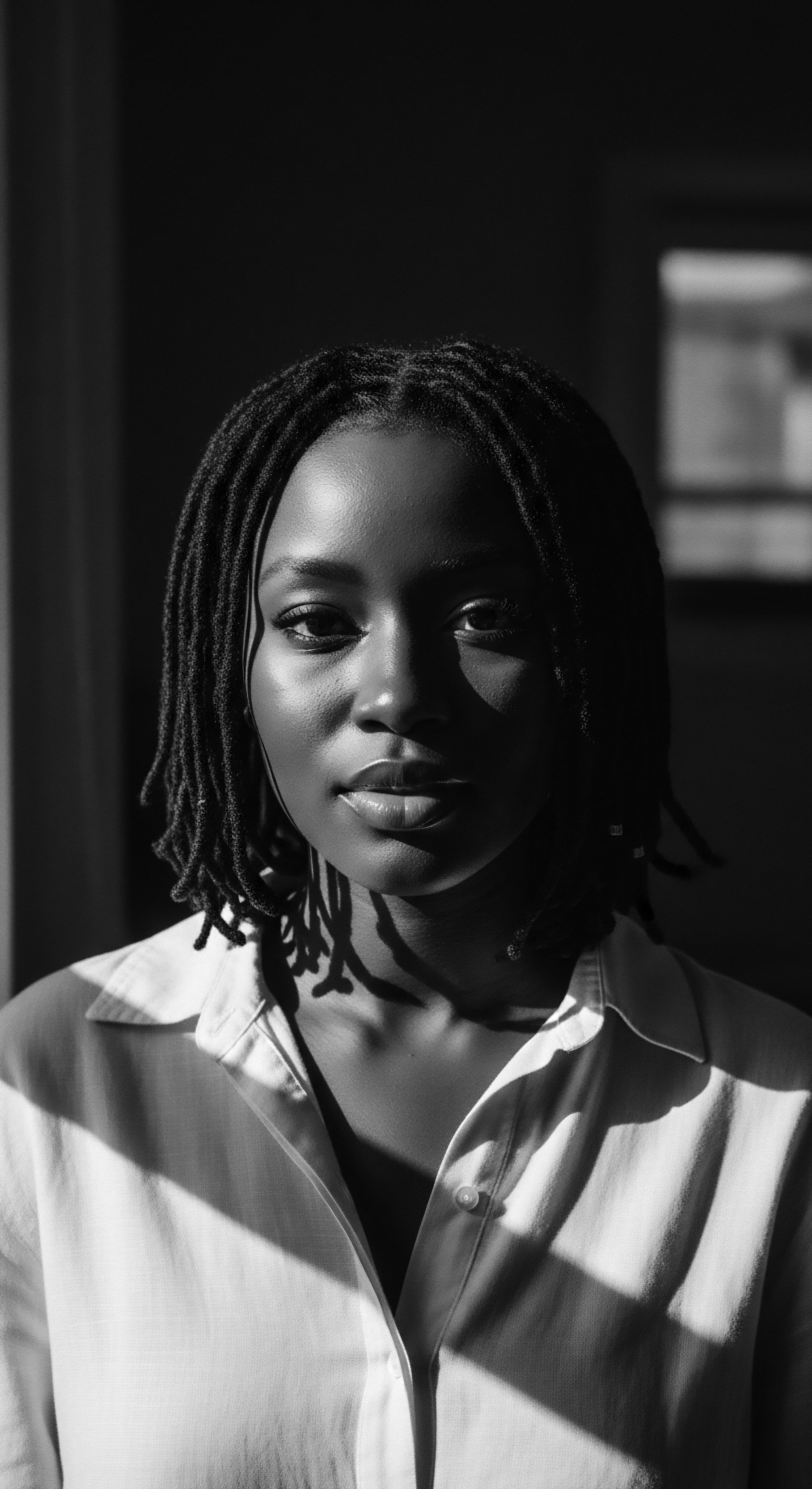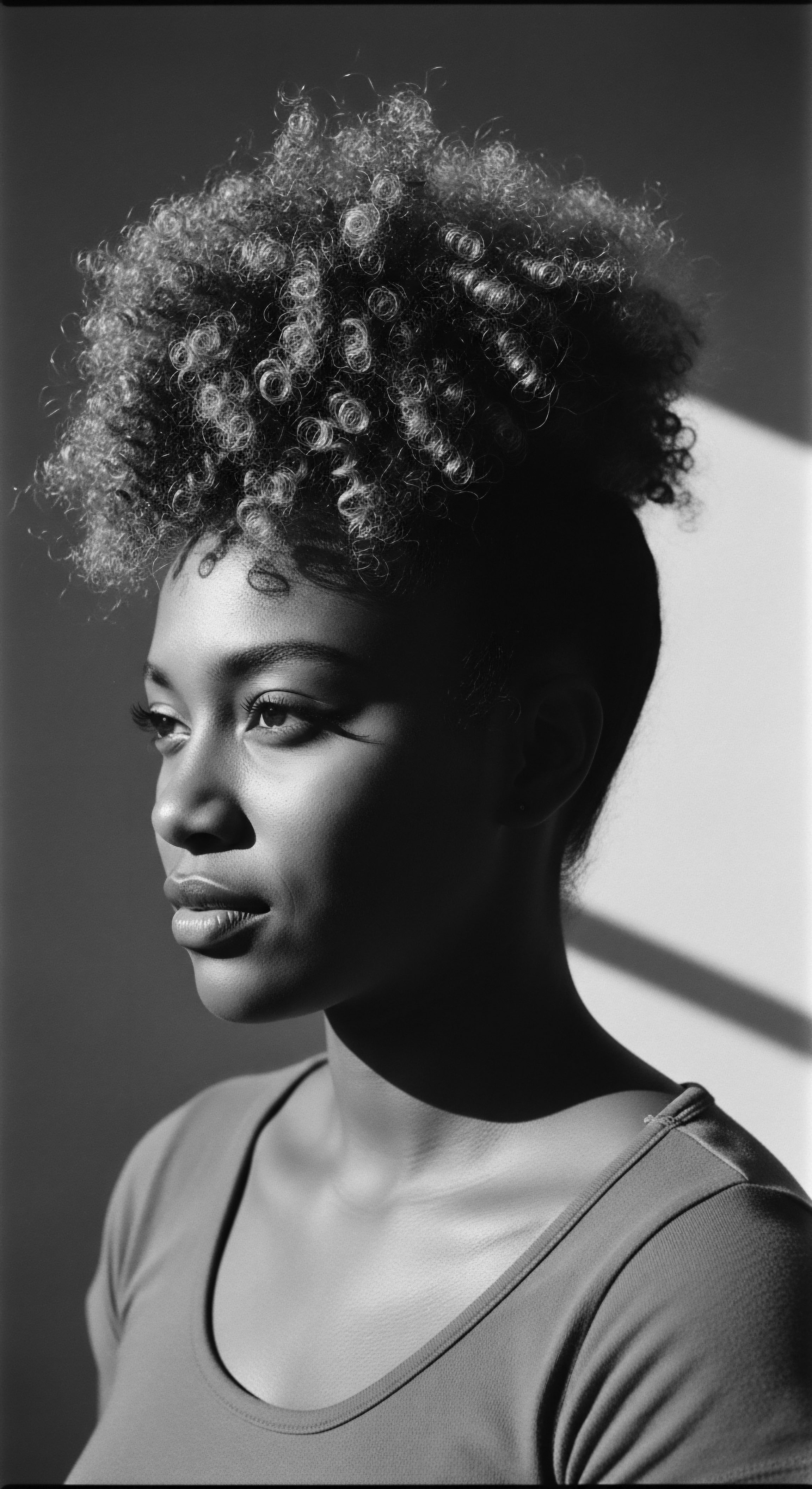
Fundamentals
The concept of Moisture Practices, at its simplest, speaks to the purposeful application and preservation of hydration within the hair strand. For textured hair, particularly that which carries the rich legacy of Black and mixed-race heritage, this fundamental understanding transcends mere cosmetic routine; it is a foundational pillar of care. Hair, much like a thriving plant, requires consistent internal hydration to maintain its pliability, its strength, and its vibrant character. Without adequate moisture, the hair’s outermost layer, the cuticle, can become raised and brittle, leading to a compromised structure susceptible to breakage and a dull appearance.
The very physical characteristics of highly coiled or curly hair patterns naturally present a unique challenge to moisture retention. The intricate twists and turns of each strand mean that the natural oils produced by the scalp, known as sebum, struggle to travel down the entire length of the hair shaft. This inherent structural quality means that these hair types are often predisposed to dryness, making intentional moisture strategies not merely beneficial, but truly essential for maintaining integrity and vitality. The deliberate replenishment of water, often sealed in with emollients, stands as a core tenet.
From ancient times, communities understood this intrinsic need. The earliest forms of Moisture Practices were not born from scientific laboratories but from intimate observation of the natural world and the properties of indigenous plants. Ancestral wisdom, passed through generations, identified specific botanicals and natural fats that offered solace to dry hair. These practices were often communal, interwoven with daily life and cultural expression.

Early Echoes of Hydration
Across various African civilizations, before the profound disruptions of colonialism, the understanding of hair’s thirst was deeply ingrained. The use of water, often infused with herbs, formed the initial layer of hydration. Following this, natural oils and butters, harvested from the local environment, served to seal in the precious liquid. This layering was an intuitive response to the hair’s inherent needs, a testament to keen observation and inherited knowledge.
- Water ❉ The primary source of hydration, often applied directly or through herbal rinses. Its elemental purity cleansed and prepared the hair for further care.
- Plant Oils ❉ Substances like palm oil, shea butter, and various nut oils were applied to coat the hair, creating a protective barrier against moisture loss. These oils, rich in fatty acids, nourished the strands.
- Herbal Infusions ❉ Decoctions from leaves, roots, and barks were used to impart conditioning properties and further assist in hydration, often possessing mucilaginous qualities.
The application of these elements was often accompanied by gentle manipulation, such as finger-detangling or careful braiding, further distributing natural emollients and minimizing stress on the hair. This careful handling ensured that the moisture applied was not merely fleeting but absorbed and retained within the hair’s structure, allowing the strands to maintain their supple nature. The fundamental principle was clear ❉ provide hydration, then safeguard it.
Moisture Practices, at its foundational core, is the deliberate act of providing and securing hydration for textured hair, a practice rooted deeply in ancestral wisdom and the unique biological needs of the hair strand.
The basic meaning of Moisture Practices, therefore, is a cyclical process of hydration and protection. It acknowledges the hair’s natural inclination towards dryness and counters it with intentional, systematic care. This early understanding, though not articulated in modern scientific terms, laid the groundwork for all subsequent developments in textured hair care, demonstrating a timeless connection between the hair’s well-being and the natural world.

Intermediate
Moving beyond the foundational principles, an intermediate understanding of Moisture Practices delves into the interplay between hair structure, environmental factors, and the cultural evolution of care routines. The significance of these practices extends beyond simple hydration; they represent a continuous dialogue between inherited hair characteristics and the lived experiences of individuals across the African diaspora. This dialogue has shaped rituals that both protect and express identity.

The Hair Strand’s Intimate Connection with Water
At a slightly more detailed level, the hair strand’s ability to interact with water is governed by its chemical composition and physical architecture. Hair is primarily composed of keratin, a fibrous protein. Within the keratin structure, there are specific sites that readily attract and bind water molecules. This phenomenon, known as hygroscopy, allows hair to absorb moisture from its surroundings.
However, for highly coiled strands, the journey of this moisture, and its subsequent retention, presents complexities. The cuticle, the outermost layer of the hair, consists of overlapping scales. In textured hair, these scales tend to be more lifted or less tightly sealed than in straight hair, allowing moisture to escape more readily. This inherent characteristic underscores the sustained necessity of proactive moisture strategies.
The concept of hair Porosity becomes particularly relevant here. Hair porosity refers to the hair’s ability to absorb and retain moisture. High porosity hair, often characterized by raised cuticles, absorbs water quickly but also releases it just as fast. Low porosity hair, with tightly closed cuticles, resists water absorption initially but, once hydrated, retains moisture effectively.
Understanding one’s hair porosity, a concept intuitively grasped by ancestors through observation of how their hair responded to different natural applications, guides the choice and sequence of moisturizing agents. This knowledge, though not formally categorized until recent times, informed the selection of specific plant oils or butters for various hair types within a community.

A Legacy of Layered Care
Across generations and continents, the methods for delivering and preserving moisture adapted to new environments and available resources, yet the core principles persisted. The sequential application of liquid, oil, and often a thicker balm or cream, a modern concept often referred to as the “LOC method,” finds its conceptual roots in these historical practices.
| Region/Community West Africa (e.g. Yoruba, Ashanti) |
| Traditional Moisture Agents Shea butter (nkuto), Red palm oil, various herbal infusions |
| Application Techniques Applied after water-based cleansing, often massaged into scalp and strands, followed by protective styles like braids or twists. |
| Region/Community Caribbean (e.g. Jamaica, Haiti) |
| Traditional Moisture Agents Castor oil (black castor oil), Coconut oil, aloe vera, plantain leaves |
| Application Techniques Used as pre-shampoo treatments, hot oil treatments, or applied to damp hair and sealed with head wraps or cornrows. |
| Region/Community African American (Post-Emancipation) |
| Traditional Moisture Agents Greases (often petroleum-based initially, later incorporating natural oils), Water-based pomades, home-made herbal infusions |
| Application Techniques Regular application to scalp and hair, often to soften and make hair more manageable for styling, a continuation of the sealing practice. |
| Region/Community These diverse approaches highlight a shared ancestral wisdom concerning the systematic application of moisture and protective agents for textured hair. |
The consistent use of these layered approaches, often intertwined with daily grooming rituals, served a dual purpose ❉ practical hair health and profound cultural expression. Hair was not merely adorned; it was nurtured, a living extension of self and community. The selection of specific ingredients often carried symbolic significance, connecting the individual to the land, to ancestors, and to collective identity.
The journey of Moisture Practices reflects a dynamic adaptation of ancestral wisdom, with layered care routines evolving across diasporic communities to address the unique porosity and structural needs of textured hair.
The understanding of Moisture Practices at this level recognizes the profound connection between the hair’s physical attributes and the socio-cultural contexts in which it exists. It acknowledges that the methods of hydration are not static but have been shaped by environmental constraints, available resources, and the enduring spirit of communities preserving their hair heritage against considerable odds. This historical perspective provides a richer interpretation of why certain ingredients became staples and why particular routines persisted through generations.

Academic
The academic elucidation of Moisture Practices demands a rigorous examination of its biophysical underpinnings, its profound anthropological resonance, and its enduring socio-cultural significance, particularly within the continuum of textured hair heritage. This deep inquiry reveals that Moisture Practices are not merely a collection of techniques, but a sophisticated, adaptive system of care rooted in both elemental biology and a rich ancestral epistemology concerning hair health and identity. The core meaning of Moisture Practices, viewed through this scholarly lens, is the deliberate and informed manipulation of the hair fiber’s hydration state to optimize its mechanical properties, enhance its aesthetic appeal, and sustain its cultural semiotics, especially for hair exhibiting complex helical geometries.

Biophysical Dynamics of Hair Hydration
At a molecular level, the interaction of water with the keratinous structure of textured hair is a complex phenomenon. The cortex, the main bulk of the hair fiber, comprises tightly packed keratin macrofibrils. These macrofibrils contain amorphous regions rich in amino acids with hydrophilic side chains (e.g. serine, threonine, glutamic acid, aspartic acid) that readily bind water molecules through hydrogen bonding.
This water absorption causes the hair fiber to swell, increasing its diameter and altering its mechanical properties, making it more pliable and less prone to fracture during manipulation. However, the tortuous path of sebum along the coiled shaft, coupled with the often-raised cuticle scales characteristic of highly curly or coily hair, compromises the hair’s natural barrier function, leading to accelerated trans-epidermal water loss (TEWL) from the scalp and transepithelial water loss from the hair fiber itself. This inherent vulnerability to dehydration necessitates external intervention to maintain optimal hydration levels.
The scientific rationale behind Moisture Practices, therefore, centers on two primary mechanisms ❉ Humectancy and Occlusion. Humectants, such as glycerin or honey (often derived from traditional sources), attract water from the atmosphere and bind it to the hair. Occlusive agents, typically oils and butters, then form a hydrophobic film on the hair surface, minimizing the evaporation of the absorbed water.
The efficacy of traditional ingredients like Shea Butter (Butyrospermum parkii) and Coconut Oil (Cocos nucifera) in contemporary Moisture Practices is directly attributable to their fatty acid profiles, which provide both emollient and occlusive properties. Shea butter, for instance, is rich in stearic and oleic acids, creating a substantive film that reduces water vapor transmission from the hair shaft.

Ethnobotanical Wisdom and Ancestral Resilience
The deep historical meaning of Moisture Practices is inextricably linked to ethnobotanical knowledge accumulated over millennia by African communities. Long before the advent of modern chemistry, these societies possessed an intuitive understanding of plant properties and their therapeutic applications for hair. The sustained practice of hair oiling and butter application, particularly in West Africa, served as a primary strategy for managing the unique hydration needs of textured hair. This is exemplified by the pervasive use of shea butter.
A powerful historical instance that underscores the enduring significance of Moisture Practices within textured hair heritage can be found in the forced migration of enslaved Africans. Despite the brutal conditions of the transatlantic slave trade, which stripped individuals of their autonomy, culture, and often their personal belongings, the knowledge and practice of hair care, including moisture retention, persisted. Enslaved people, often denied access to traditional ingredients, ingeniously adapted, using what was available—animal fats, rudimentary oils, and even discarded food items—to maintain their hair. This was not merely about aesthetics; it was an act of profound cultural resistance and self-preservation.
As recorded by various historians and scholars of the Black diaspora, hair became a silent repository of identity, a canvas for continuity. For instance, Dr. Ayana Byrd and Lori Tharps, in their seminal work, document how even under duress, Black individuals maintained hair practices, often using whatever meager resources were available, to preserve a sense of self and connection to ancestral ways. This continuity, albeit adapted, directly speaks to the critical importance of moisture for the health and appearance of hair, and its symbolic weight in resisting dehumanization. The persistence of practices like scalp oiling and hair greasing, even with altered ingredients, highlights the ancestral understanding of sealing moisture as a non-negotiable aspect of textured hair care, a testament to the resilience of cultural knowledge systems (Byrd & Tharps, 2001).
The historical continuity of Moisture Practices, even amidst the profound disruptions of enslavement, stands as a powerful testament to their deep cultural and physiological necessity for textured hair.
This historical adaptation underscores a critical point ❉ the knowledge system surrounding Moisture Practices was not fragile; it was robust and adaptable. It was transmitted orally, through observation, and by necessity, across generations and geographical boundaries, demonstrating a remarkable resilience in the face of immense adversity. The traditional application methods, such as braiding and twisting, were not only protective styles but also served to distribute and lock in moisture, minimizing environmental exposure and mechanical stress.

The Sociocultural Semiotics of Hydrated Hair
Beyond the physiological benefits, the meaning of Moisture Practices extends into the realm of socio-cultural semiotics. Hydrated, well-maintained textured hair has historically functioned as a potent symbol of health, status, and identity within African and diasporic communities. In many pre-colonial African societies, intricate hairstyles, often requiring significant moisture and care to maintain, communicated marital status, age, tribal affiliation, and even social standing. The very act of caring for hair, particularly through communal grooming sessions involving moisture application, served as a binding social ritual, strengthening familial and community ties.
In the context of the diaspora, especially for Black communities in the Americas, Moisture Practices became a quiet act of self-affirmation against prevailing Eurocentric beauty standards that often denigrated natural textured hair. The diligent application of oils and butters, the creation of protective styles, and the communal sharing of hair care knowledge represented a reclamation of agency and a defiant celebration of inherited beauty. This was a form of self-love and community care that countered systemic attempts to erase cultural identity.
The long-term consequences of neglecting moisture, both physiologically (dryness, breakage) and psychologically (feelings of inadequacy, disconnection from heritage), are profound. Conversely, the consistent application of Moisture Practices yields hair that is not only physically healthy but also symbolically rich, embodying resilience, beauty, and ancestral connection.

Interconnected Incidences ❉ Health, Identity, and Economics
The impact of Moisture Practices extends into public health and economic spheres. Historically, the lack of culturally appropriate and adequately moisturizing products led to significant hair damage among Black populations, contributing to conditions like traction alopecia and breakage. The modern natural hair movement, deeply rooted in a return to traditional Moisture Practices, has not only spurred a demand for effective products but also driven a re-evaluation of beauty standards and a celebration of natural hair textures.
This shift has created a multi-billion dollar industry, demonstrating the economic significance of practices once relegated to the margins. This resurgence is not merely a market trend; it is a profound cultural statement, a collective decision to prioritize the health and integrity of textured hair through methods that honor its heritage.
The delineation of Moisture Practices, therefore, encompasses a holistic understanding ❉ from the microscopic interactions of water and keratin to the macroscopic expressions of cultural identity and economic agency. It is a testament to the enduring wisdom of ancestral care, validated and expanded by contemporary scientific understanding, all converging to affirm the profound value of textured hair.

Reflection on the Heritage of Moisture Practices
As we draw our understanding of Moisture Practices to a close, we are invited to consider not just its scientific definitions or its historical markers, but its enduring spirit. This concept, far from being a static point of knowledge, is a living stream, flowing from the wellspring of ancestral wisdom through the present moment, shaping the futures of textured hair. It is a profound meditation on the very soul of a strand, a testament to its resilience and its innate connection to heritage.
The diligent attention to moisture, passed down through countless hands and whispered through generations, speaks to a deep respect for the hair as a vital part of self. It reminds us that care is not merely about products, but about connection—connection to our bodies, to our lineage, and to the earth that provides the ingredients for our nourishment. Each application of water, each anointing with a precious oil, echoes the touch of an ancestor, a silent conversation across time.
The significance of Moisture Practices in the narrative of textured hair is one of enduring strength. It is a story of adaptation, of ingenuity, and of a steadfast refusal to abandon what is inherently good and true. In the face of erasure, these practices became acts of quiet rebellion; in times of plenty, they were celebrations of beauty. They stand as a vibrant thread, linking the present-day routines in our bathrooms to the communal grooming rituals of ancient villages.
This journey of understanding, from elemental hydration to profound cultural expression, allows us to view our hair not as a challenge to be overcome, but as a sacred inheritance to be honored. The continuous pursuit of moisture, the conscious choice to nourish and protect, becomes a daily affirmation of identity, a joyous declaration of belonging to a heritage rich in wisdom and beauty. The future of textured hair care, then, is not about inventing entirely new paths, but about rediscovering and reinterpreting the ancient pathways of moisture, allowing the unbound helix to flourish in all its magnificent glory.

References
- Byrd, A. & Tharps, L. D. (2001). Hair Story ❉ Untangling the Roots of Black Hair in America. St. Martin’s Press.
- Garnier, J. (2018). The Chemistry of Hair. Royal Society of Chemistry.
- Robbins, C. R. (2012). Chemical and Physical Behavior of Human Hair. Springer.
- Opoku-Boahen, Y. (2016). The Cultural Significance of Hair in African Societies. Journal of African Studies, 43(2), 187-201.
- Khumalo, N. P. & Gumedze, F. N. (2015). African Hair ❉ A Cultural and Scientific Perspective. Springer.
- Nkengne, A. & Njimou, J. R. (2019). Ethnobotany of African Hair Care ❉ Traditional Uses of Plants for Hair Health. Journal of Ethnopharmacology, 245, 112167.
- Lewis, L. A. (2017). The Black Hair Handbook ❉ A Guide to Natural Hair Care. Black Dog & Leventhal Publishers.
- Bamidele, T. (2010). The Role of Traditional African Hair Care Practices in Modern Cosmetology. International Journal of Cosmetic Science, 32(3), 205-212.
